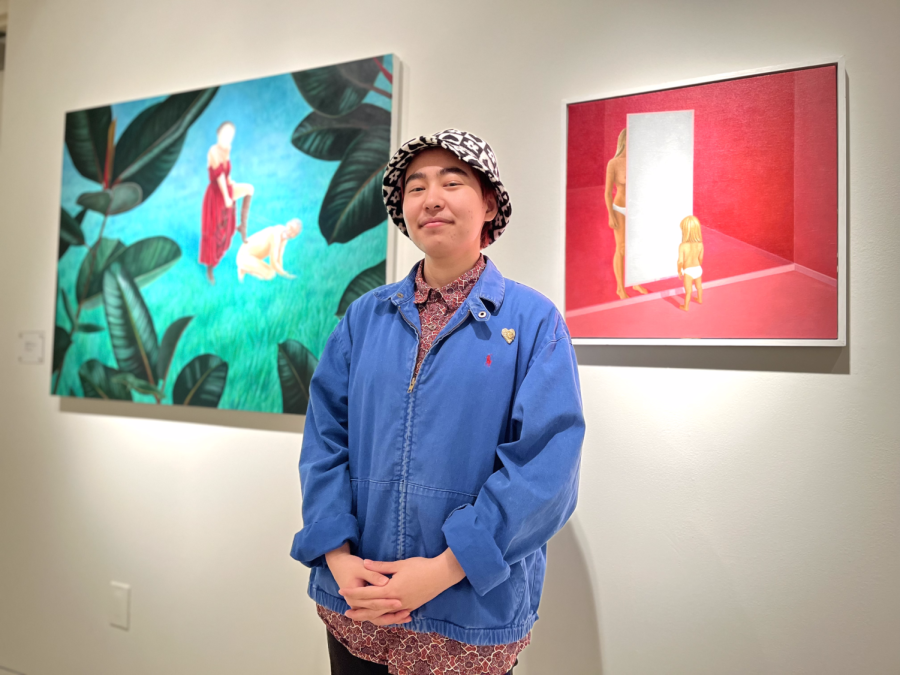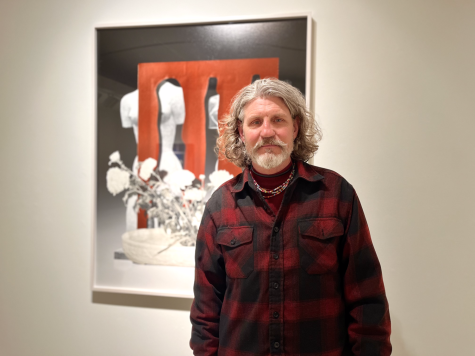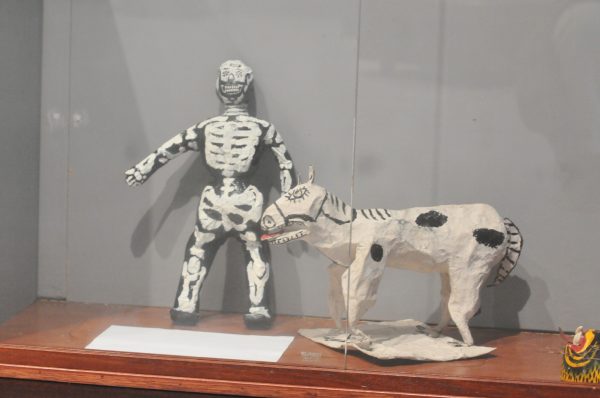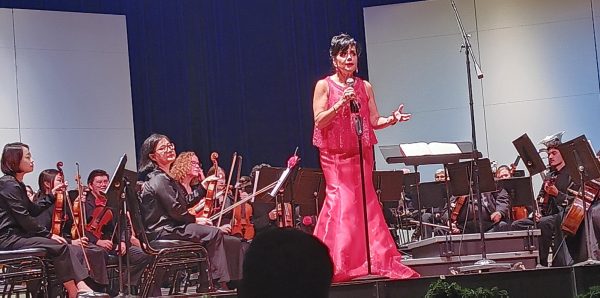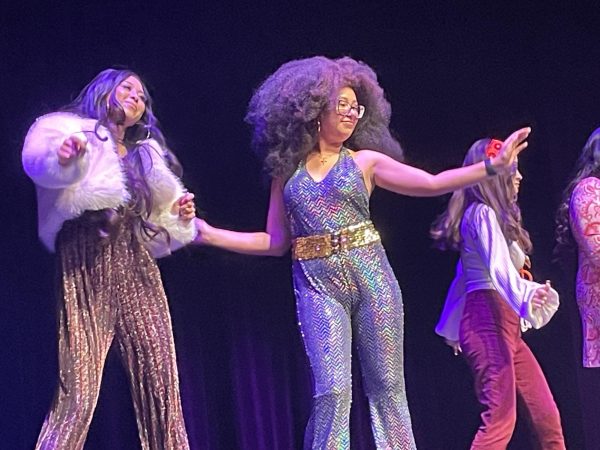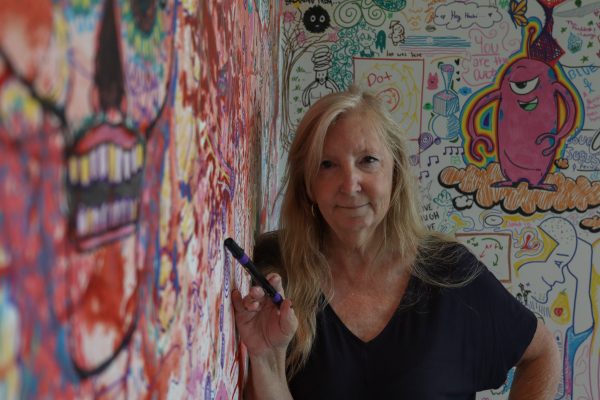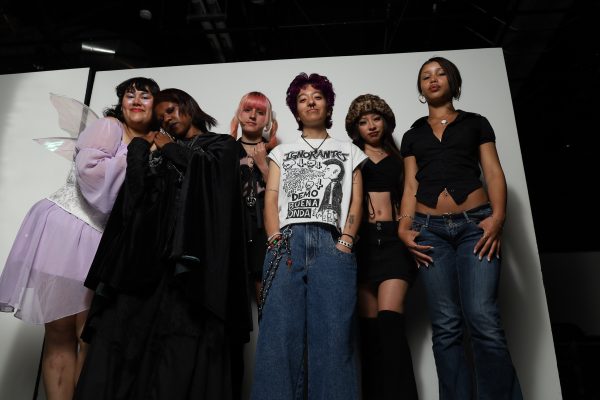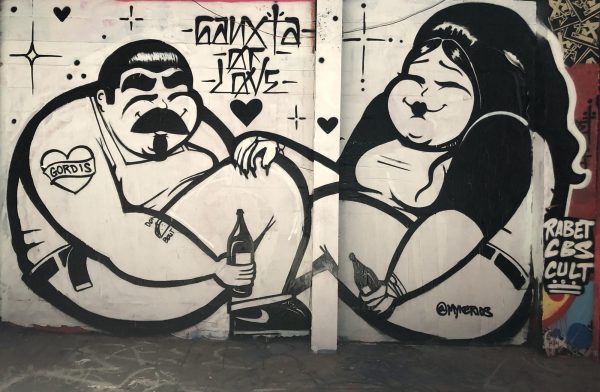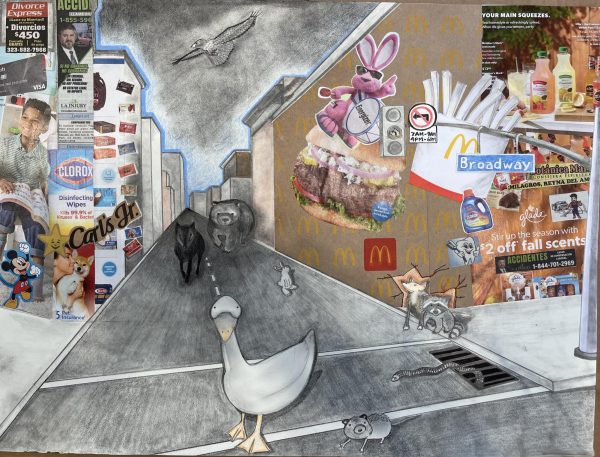Finding belonging across different spaces through art
His journey in art began in the first space he occupied – his own home.
The ceramic mug that holds his coffee. The textiles of the plastic cover draped over the dinner table. The engraved kitchen tiles. The religious images such as the Crucifix on the walls. The sculptures of the Virgin Mary adorning the altar.
Even from simple objects one can make practical use out of every day, Marcus saw works of art in his Mexican household at an early age.
“Those are pretty to look at, but they’re also things that you wrap yourself around and feel comfort with,” Marcus says. “My hope, my vision is that kind of art could bring comfort and solace to the human experience.”
Through the emphasis of cultural identity and individual belonging in art, El Camino College studio art and psychology student Marcus Masaki Rodriguez tells stories of domesticity across many spaces – whether in a classroom, the museum or his own abode.
Born in Los Angeles to a Japanese mother and Mexican father, Marcus spent a lot of his life navigating two cultures and seeing how concepts of intimacy and domestic life differ from home to home.
“Growing up like that, the idea really stuck with me, like how do we find a home? And what constitutes as a home?” Marcus says.
Outside his biological family, he found a deeper sense of belonging in a “found family” as a queer individual. Valuing domesticity and vulnerability through his experiences, such themes ultimately inspired the art gallery Marcus later curated for the Torrance Art Museum.
“Cultivating a space where you can be yourself and be vulnerable with people around you – that’s an important idea to me,” Marcus says.
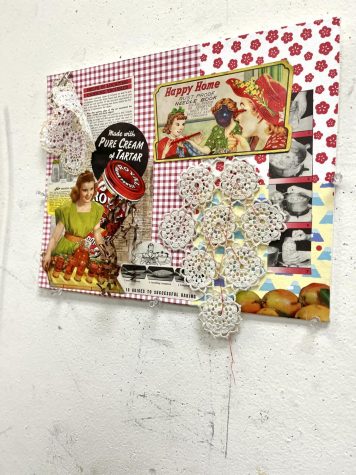
(Maureen Linzaga | Warrior Life)
His parents met in a cosmetology school in Hollywood, where both studied creative careers such as movie production and doing actors’ makeup. This exposed him to the world of aesthetics and creativity at a young age.
Marcus’ dad is now a writer of children’s books who creates detailed pen-and-ink illustrations of creatures in the fantasy stories, which further encouraged Marcus’ imagination as a child.
“I think my art style’s very, very different,” Marcus says. “But I definitely have that same love for the arts and the same artistic eye.”
His mother no longer pursues the arts and is now working as a social worker among the Asian homeless population in Downtown Los Angeles.
Like her, Marcus felt a strong fondness for his Asian roots.
Marcus recalls sitting in the backyard of his grandparents’ house in Osaka, Japan, letting his curiosity run free by making ‘plant soup’ or makeshift tea by cutting grass, putting in water and telling his mom to eat it.
“Although obviously she wouldn’t,” Marcus adds with a laugh. “I was always curious, always enjoyed beauty, I found a lot of value and comfort in aesthetic practices.”
Marcus spent most summers visiting his Osaka home, observing Japan’s culture of communally living with extended family and relatives.
“In Japan, there’s such a big emphasis on the collective and working with other people. In America, my experience has been very individual, it’s a very ‘Man for himself’ kind of idea,” Marcus says.
Marcus says the biggest similarities in both his Japanese and Mexican homes are the environments where a lot of people lived closely, allowing him to spend time with many generations of different cultures.
Marcus moved from his Mexican household at 13 years old to now live with his mom and brother in Torrance, which he finds more suitable as an adult who values independence. His dad currently lives in another area of California for work.
“As an introvert, I didn’t really like it. I really liked my own space. I think I much prefer this environment that I’m in now … I have much more freedom and control,” Marcus says.
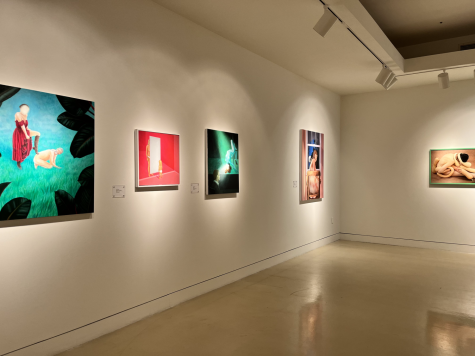
Occupying an even broader space in his art career at 21 years old, Marcus curated his first art show “Closer Now: Intimacy in a Rehabilitating Society” which was available to be viewed for free in Torrance Art Museum (TAM) from April 2 to May 14.
With zest as bright as the artwork mounted to the four walls surrounding Marcus, his irises of deep mahogany roam over the colorful textures of Phyllis and Aristotle’s story as told through acrylic paint.
“Closer Now” featured artwork surrounding themes of intimacy, gender dynamics and domestic relationships, especially in regard to the COVID lockdowns that have altered many relationships whether public, private, or even with the self.
“I know at least from my experience, [COVID] drove me and my family a little crazy,” Marcus says, a smile apparent behind his face mask. “As we’re living in close proximity, we have this very personal idea of what it means to relate to others, and how that kind of helps us learn about ourselves in the process.”
Marcus says the painting by Palmer Earl of Phyllis and Aristotle is his personal favorite artwork in the gallery, as it shows a unique relationship that challenges gender dynamics and the woman is seen as more dominant.
Ryan Schude, a 43-year-old photographer from Chicago whose work was also featured in the show, highlighted similar themes of vulnerability and gender dynamics in relationships. One of the photographs entitled “Kitchen” captures him and his wife portraying a couple arguing over the dinner table.
“I think it’s an amazing opportunity for [Marcus] to have, to be able to get that well-established of an institution to curate a show at that age,” Ryan said. “Being the age the I am, I was pleased to have any sort of connection with a whole different generation that I generally don’t have chances to work with except for shoots.”
In June 2021, Marcus received a Getty Marrow Undergraduate Internship to work at TAM, the first grand opportunity that made his curation possible.
Selene Preciado, program associate at the Getty Foundation, says the internship is one of many efforts made to make museum staff reflect the demographics of Los Angeles and address the lack of diversity in more prestigious institutions like Getty.
In the Getty Marrow Undergraduate Internship, interns such as Marcus gain a stipend of $6,400 for a consecutive 10-week work period between June to August for around 120 interns annually.
The foundation will celebrate 30 years this summer, as its genesis was marked by a historical period of Los Angeles riots following the beating of Rodney King.
“The region was serving in upheaval. Many cultural institutions, including the Getty, had conversations about how to help our community in different ways,” Selene says. “One of the ways was to open the museum doors.”
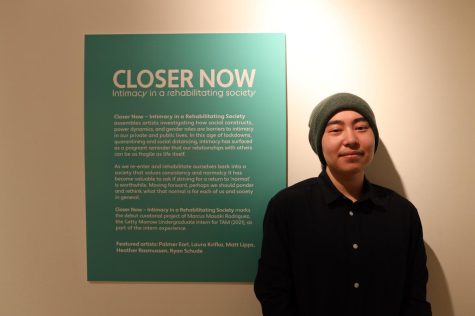
As an artist with different backgrounds and identities, Marcus applied after being drawn by the program’s emphasis on diversity.
“Walking into a museum as a young man of color, as someone with a queer identity, it’s hard to either feel like I can relate or feel a sense of belonging in the space,” Marcus says.
Numerous alumni of the internship program now work at similar institutions such as Cameron Shaw, director of the California African American Museum.
“Obviously, an internship is not going to solve systematic issues, because field-wide, the arts are very much like an elite sort of field, but the internship is sort of like the catapult that helps them get started,” Selene says.
Selene also resides in Torrance and has years of curatorial experience. Being of Hispanic heritage herself, Selene says she sees herself in Marcus and the young professionals starting their art careers.
“I read like over 100 resumes and I’m just blown away by the brilliance of everyone every year and it is very humbling,” Selene says. “As a professional of color, by offering my experiences and my struggles and my successes in the arts, I also hope to help younger generations.”
At the beginning of the internship process, Marcus recalls being in a Zoom meeting with around 120 other interns and being one of the only community college students.
“Most of them were like, ‘Oh, yeah, I just got my bachelor’s from UCLA and went to Stanford,’” Marcus says, eyes wide in disbelief as he reminisces. “I was like ‘Oh my god, like what am I doing here?’”
Selene agrees, and says that the Getty Internship program is not only competitive for the students, but also for the organizations because organizations go through extensive review processes.
As part of the internship that lasted from June to August of 2021, Marcus was asked to create a hypothetical exhibition.
Max Presneill, a Los Angeles-based artist from the United Kingdom and director of TAM for 13 years, was so impressed with Marcus’ gallery proposal that the museum pushed to bring the exhibit to life.
The experience was TAM’s first time ever offering the chance to curate to an intern. With the help of the museum curators and staff, Marcus was aided in the process of putting the pieces together.
“I think what he’s done a good job here, he’s looked into intimacy in an off-kilter way that makes us reassess what we might mean by ‘intimacy’ – such as what does it mean in a pandemic? And what does it mean to us individually,” Max says.
Max says that the key characteristics that they saw in Marcus when interviewing interns for the museum is that he was responsible, can get the job done and was a self-starter. What also impressed Max from the beginning is that Marcus asked very “intelligent, pertinent” questions.
“No offense to young people, but that isn’t that common,” Max says. “There’s a lot of questions from people that’s like ‘Really? Is that all you’re gonna ask me when you have the opportunity?’”
In the internship, Marcus had roles of volunteer orientation training, directly examining art pieces to see if any were damaged along the shipping process or as they are exported back out, doing research on artists and galleries, writing articles and conditioning reports and even promotional aspects through updating the museum’s website and social media.
Going up and down a five-story building in August 2021, Marcus also did these tasks in the pop-up show “Nomad”, which featured around 500 contemporary artists at Del Amo Crossing Medical Center Building.
A week after the “Closer Now” opening night, although his 2021 internship was over, Marcus took a group of disabled individuals from the city-based non-profit organization Diverse Journeys on a tour around the gallery.
Marcus, however, originally did not want to pursue art when he went to college. After graduating from high school, he went to El Camino with hopes of pursuing a psychology degree.
After taking his first-ever drawing class, he felt supported in the beginning of his art journey and decided to pursue a studio art major.
Marcus was set to transfer in fall 2021 after getting his art certificate, but COVID decreased studio art classes he could take. He instead took the chance to continue his psychology certificate at El Camino to be finished in June 2022.
“Art and psychology are definitely still related because at the end, my root purpose, desire or drive is to understand people,” Marcus says. “Art, music, dance, literature, anything like that can directly speak to how we interact with the world on an emotional basis.”
As Marcus pursues both art and psychology degrees, many encouraged him to go into art therapy as it is a helpful tool for dealing with mental health through creativity. But Marcus says he wants to pursue each area separately.
Ultimately, one of his main goals is to be an art educator. Now, Marcus is gaining mentorship experience as a teacher’s assistant for El Camino art professor Joseph Hardesty in the very same intro to art class he was in.
And yet again, he occupies another space, this time the very classroom that deepened his love for art.
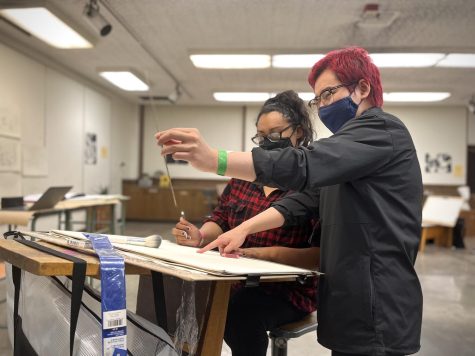
Joseph says he was teaching beginning drawing when Marcus voluntarily gave his time, suddenly started showing up early and staying after classes to help.
“I’ve always got way too much crap to do,” Joseph laughs. “I needed a TA and he was so helpful and so amazing … so he started working for me as a TA before the pandemic.”
Marcus eventually became part of MyPath, a program in El Camino College that Joseph says essentially attaches the course to a counselor and a student who’s already taken the class. Marcus serves as a tutor and helped students in their art projects, navigating campus and much more.
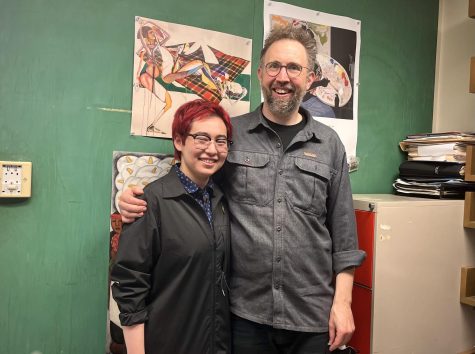
He then became the vice president of the Future Teachers Club comprised of El Camino students pursuing education fields.
Marcus says Joseph, through MyPath and his mentorship, was one of the reasons why Marcus felt supported in his journey as an art educator. He was even the first to let Marcus know about the Getty internship during winter 2021.
“Marcus is so hard working, so talented and smart and all that stuff, but none of that would mean anything if he wasn’t willing to put himself out there. That would be my advice to students,” Joseph says. “Even if you don’t get it, you learn something from the process and you’re more prepared for the next opportunity.”
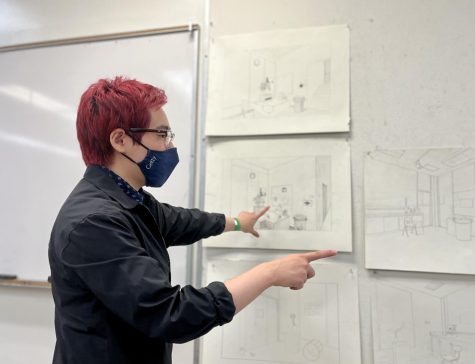
Marcus certainly took another opportunity. He had the honor of receiving the Getty Undergraduate Internship once again to work at the Museum of Latin American Art (MOLAA) at Long Beach in summer 2022.
Being assigned to a museum focusing on Hispanic artistic works this time around, Marcus aims to learn more about his culture and Mexican descent, carving more of his identity into yet another space.
“I remember [MOLAA] has galleries with religious iconography because Catholicism is like a big part of [Hispanic] culture too,” Marcus says. “It’s going to be interesting seeing how not only I relate to the works that we’re going to be showing, but also what kind of works that I’m going to be specifically drawn to. I’m excited to explore that as well.”
Marcus hopes to continue employing spaces that value belonging and creative expression to motivate his future students into doing the same in the process.
“That idea of comfort really feeds into the greater sense of intimacy and an environment where you’re able to just be yourself without worrying about how you’re being perceived,” Marcus says. “Because you’re like, ‘With these artworks in the background, and visual items I find beauty in? Oh yeah, this is my space.’”



